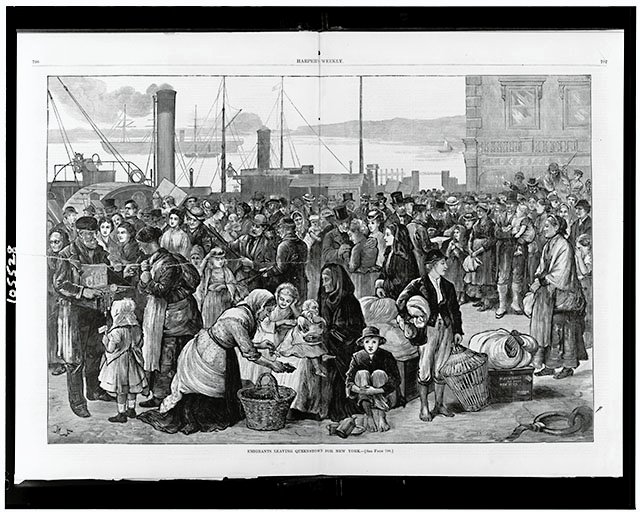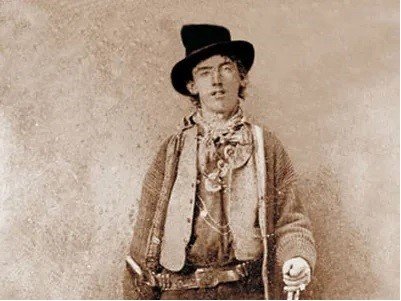In this second part of a two-part blog series looking at the migration of folklore and belief, I look at how folklore has been used as a way to make sense of the emigrant experience and how in some cases new folklore emerges as people create new identities outside of the original homeland.
Diaspora and liminal space
In Celtic mythology and folklore, liminal spaces were thought to be special, marking boundaries between the spiritual and the apparent world, places where magic happens more readily. ‘Liminal’ comes from the Latin limen, meaning threshold, it describes the space between.
Dusk, between night and day; May-eve or All Hallows Eve, as the seasons change; crossroads and bridges; all these times and places were thought to hold potential and power, their betwixt quality allowing people to move from one place or state to another, helping to free people from old habits and rigid paths. All manner of folkloric beings, including fairies, would be more active in liminal times and spaces.

From: https://www.prints-online.com/gorse-fern-fairies-out-may-eve-custom-14365221.html
Typically, a ‘diaspora’ is defined as being produced by the movement from a home country and resettlement in a ‘host’ country of large numbers of people, often due to traumatic dispersal (such as occurred during the Irish famine), but sometimes due to work, trade or the expansion of empire [1]. This resettlement produces a community in the new country that is both within the host country and also separate from it. And so here a cultural liminal space exists, a space between one thing and another.
When studying the migration of folklore and belief, I was struck by this liminality, and I wondered what happened to Celtic folklore in its own liminal space of diasporic community? Large numbers of people emigrated from Ireland to America from at least the 17th, well into the 20th century, and though the 19th century famine is often seen as the ‘Charter myth’ of the Irish-American community, in fact diverse groups of Irish emigrants from different backgrounds moved to America over centuries [2]. And so as Irish people moved, settled into a new culture, experienced nostalgia for Ireland, escaped oppression at home, experienced discrimination in America, yet paradoxically became part of a colonising culture in the ‘new world’, how did their changing identity express itself through their myths and stories?
I looked in the last post at whether those that emigrated took with them the fairies of the landscape of their home. In this post I’ll explore the use of folklore in the expression of the experience of nostalgia, homesickness, and the sense of ‘otherness’ in emigrant communities, and in the emergence of new identities on the American frontier.

Translocations and nostalgia
Fairy legends can act as a collective store of memory or metaphor, and even of local ecological knowledge [3], and they can also provide a way of expressing otherwise difficult sentiments. Some fairy legends concerning translocation or magical travel under fairy influence, carry an obvious sense of longing for connection between emigrants with those left behind in Ireland, and of the nostalgia of an exile for the homeland.
In one story collected in 1938, and translated from the original Irish by Sean O’Sullivan, [4] fairy influence is heavily implied but not mentioned directly:
A man recently emigrated to America is on his way home to his lodging one night after a visit to Irish friends. He encounters a funeral, and according to rural Irish practice, turns to walk three paces along with it, whereupon he finds himself back home in Ireland, at the graveyard in Gorumna, next to the house where he grew up. He goes into his old home, where the occupants are all out for the evening, and eats some potatoes from a pot being kept warm beside the fire. Then he goes back to the graveyard, attends the funeral, and afterwards finds himself back on the street in America, but not before driving his knife, on which his name is carved, into the ground beside his father’s headstone. He writes to his family in Ireland, telling of his adventure. They remember missing some potatoes from the pot that night and, when they go to the graveyard, find the knife stuck in the ground as he has described it.
Summary by Angela Bourke [5]
And a strikingly similar tale from a 1911 collection tells of fairy translocation in the other direction:
From County Fermanagh about 70 years ago, a man was taken to America on Hallows Eve night, and They made him look down a chimney to see his own daughter cooking at a kitchen fire. Then They took him to another place in America where he saw a friend he knew. The next morning, he was at his own home here in Ireland. The man wrote a letter to his daughter to know if she was at the place and the work on Hallow Eve night and she wrote back that she was.
Collected by Evans Wentz [6]
These tales feature liminal spaces – the funeral as a passage between life and death in the first, and Hallows Eve night in the second, and both reference food and hearth fires as a symbol of home – in the first story the man eating potatoes, warm beside the fire in his old home, carries a strong feeling of nostalgia and homesickness, and in the second the daughter cooking over her new kitchen fire symbolises her taking up root firmly in the new place. In both stories it is letters back and forth that confirm the magical event really took place.
But it is notable that these stories were collected in Ireland, not America, so may represent more how those left behind imagined their departed loved ones felt in the new world. It is hard to say whether similar tales were told on American soil, as the folklore records for the time are far scarcer.
Fairy Changelings
As discussed in the last post, the changeling is a person, often a child, abducted by the Fair Folk, and replaced with a fairy counterfeit. The changeling may look like the stolen one, but it is wholly ‘other’. It is from the fairy realm, but living in the human world, where it can never truly belong. As such it is a liminal creature, providing the perfect metaphor for emigration and exile, and the lived experience of the emigrant.
Despite its well known status as an Irish literary motif, stories of changelings are absent from early Irish sources. The mythological, Fenian and Ulster cycles of Irish mythology carry stories of fairy encounters, and of heroes being lured away into the fairy realm by beautiful fairy women, but there are no stories of changelings [7]. Yet the changeling motif is prominent in the literary works of the Irish diaspora and of authors of Irish descent, and we saw in the last post how belief in changelings led to tragic consequences on at least one occasion in New York in 1836.
To give a famous example of a member of the Irish diaspora writing heavily on fairy abductions and changeling lore, the Irish poet WB Yeats was born in Ireland but brought up in England, and used the motif extensively as he explored his own feelings of uprootedness and otherness.
Come away, O human child!
W.B. Yeats
To the waters and the wild
With a faery, hand in hand,
For the world’s more full of weeping than you can understand.
Cowboys
Many of those arriving in America from Ireland became the pioneers and frontier settlers heading West during the early period of colonisation of North America by those of European descent. Conditions on the East coast for newly arrived Irish emigrants were often harsh, and discrimination was rife, so many headed West in the hope of increased religious toleration, better prospects and a better climate – for new arrivals it was far better to be a pioneer than a vagrant [8].
And as they headed into new territory they took their folklore with them, heavily influencing the myths of the ‘Wild West’. Promises of a better life in the mythical ‘West’ tie firmly into old Irish mythology of the ‘Land of the Young’, or Promised Land, Tír na nÓg in the West, and the later Catholic stories of ‘another Eden’, also visualised as being in the West. Gerald Nash argues that the mythology of the American Western frontier is a combination of the imported European mythologies and the local impact of the environment [9]. And one of the great popularisers of the romantic idea of the Wild West was the writer John Wallace (Jack) Crawford, who was born in Donegal, Ireland in 1847 and emigrated to Pennsylvania at the age of 14.
Irish influence on Wild West myth can be seen in the cattle raiding motifs, folk tales of magical bulls or oxen, a values system based on cattle wealth and the tendency to exaggerate and mythologise heroic exploits [8]. All these motifs tie in to the early Irish literary tradition, especially the Fenian cycle and the Táin Bó Cúailnge or ‘Cattle Raid of Cooley’.
The tradition of Irish aisling or vision poetry also has a long history of using the cow as a symbol for Ireland, and pleasingly, of the poems sometimes having been learned from fairies, but it is also interesting to note that there is a strong influence of the aisling on American cowboy ballads of this period, with for example, one American song of the aisling type recorded in Pennsylvania in 1871 [10]
The distance between the Irish earth goddess [and] the cowboy shot down in the back street of a dusty western town, is great, but it is spanned by the tenacity of the folk tradition of which we are all a part, and in this case the Irish tradition of vision poetry.
D. Wilgus [10]
Out of the liminal experience of those emigrating to America then, came a new folklore of the American cowboy and folk hero, an extraordinary and heroic character, often outside the establishment and championing a libertarian ideal. One example is Billy the Kid, born to Irish parents in 1859 and achieving notoriety and fame as an outlaw and romanticised iconic figure.

From: https://www.britannica.com/biography/Billy-the-Kid-American-outlaw
In some cases then, the migrant experience produced folklore that spoke of the longing for home, kept alive the collective cultural memory, and tried to make sense of the feeling of displacement and being neither of the homeland nor the host country, of being always ‘other’. But it also produced new folklore, that took that sense of otherness and used it to create new identities and stories. emerging myths that rooted the newcomers into the new land, perhaps as a necessary step to ever feeling that now they had truly made a home for themselves.
References
1. Hickman, M.J., ‘Locating’the Irish diaspora. Irish Journal of Sociology, 2002. 11(2): p. 8-26.
4. O’Sullivan, S., Legends from Ireland. 1977, London: Batsford Ltd.
5. Bourke, A., The virtual reality of Irish fairy legend. Éire-Ireland, 1996. 31(1): p. 7-25.
6. Wentz, W.E., The fairy-faith in celtic countries. 1911: Oxford University Press.


